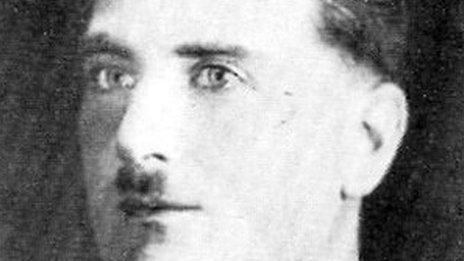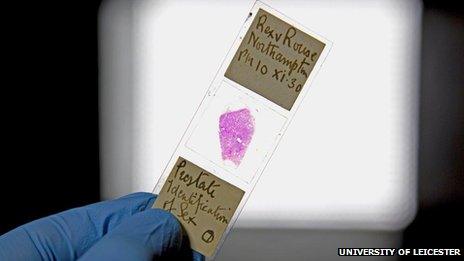DNA found in Northamptonshire 'blazing car' murder case
- Published

Alfred Rouse was desperate to start a new life and wanted to fake his own death
Scientists investigating a murder mystery dating back more than 80 years have made a breakthrough that could finally identify the victim.
A man was hit over the head with a mallet and burned to death in a Morris Minor near Northampton in 1930.
Alfred Rouse was later hanged for the crime and took the name of his victim to the gallows.
Now, a team led by the University of Leicester have uncovered DNA which they hope will reveal his identity.
In 1930, the man's badly-burned body was examined and samples taken during a post-mortem examination at a pub near the crime scene in the village of Hardingstone.
Decades later, a woman was investigating her family ancestry when her grandmother revealed her long-held belief that her uncle was the man burned to death in a car.
The uncle, William Thomas Briggs, left his home in London for a doctor's appointment in November 1930, but disappeared and was never seen again.
In the 1950s, almost 30 years after Rouse was hanged at Bedford Jail, the family asked Northamptonshire Police to reopen the case.
"My family were convinced that William was Rouse's victim," said Samantha Hall, whose grandmother had confided in her.
Mr Briggs might have crossed paths with the 36-year-old commercial traveller Rouse who it is said wanted to fake his own death.
Illegitimate children
Rouse had suffered a head wound in World War One, which left him with a personality disorder to the point that he was described as "a promiscuous rake with an enormous sexual appetite".
It is understood he fathered at least two illegitimate children and had child support orders imposed on him, leaving him with severe financial problems.
At the time, police believed he had probably picked up a homeless tramp, who would not be missed if he disappeared, and wanted the car fire on 6 November 1930 to look as if he had died in a crash.
He rendered his victim unconscious, placed the body in the driver's seat and left some of his own possessions inside before setting it on fire.
Rouse hoped the fire would go unnoticed in the early hours of the morning after Bonfire Night but two young men saw the flames and went to investigate.
The car's registration plate was still intact, identifying its owner Rouse, who had fled to Cardiff but was arrested and eventually tried for murder.
Tissue samples
Intrigued and determined to find answers for her family, Ms Hall contacted Northamptonshire Police in 2012 - hopeful that DNA profiling could result in a positive identification.
But the blazing car murder, although a mystery, was not classed as a "cold case" because it had ended with a criminal conviction.
The family were put in touch with the University of Leicester, which successfully identified King Richard III when bones were found under a Leicester car park in 2012.
A different team of forensic scientists took on the blazing car murder case and obtained a tissue sample taken from the victim during his post-mortem examination.
Along with his jawbone, the sample had been archived in the 1930s at the department of forensic medicine at the London Medical College, now Queen Mary College.
The key to solving the riddle would be finding enough mitochondrial DNA (mtDNA) in the sample to get a profile to compare with the family's mtDNA.
For months, the forensic team, along with the university's departments of chemistry and criminology, worked with Northumbria University, Northamptonshire Police and The Royal London Hospital Museum.

The University of Leicester examined a sample taken from the man's prostate
"Fortunately, the scientists obtained a full single male mtDNA profile from the slide to compare to the family," a spokeswoman for the team said.
"It's been very interesting and rewarding working on such a famous local murder case.
"It was a unique investigation to be involved in, as the perpetrator had been identified long ago and brought to justice while the victim's identity remained unknown.
"The scientific and criminological expertise at the University of Leicester and Northumbria University, working together with the police, could provide answers to this family after 83 years."
The result is due to be revealed to Ms Hall and the family on the BBC's The One Show on a date to be fixed.
- Published3 May 2012